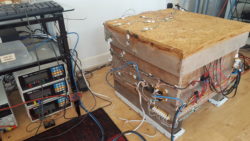LIFD Early Career Researcher Spotlight: Derek Mitchell

Our monthly spotlight on the work and lives of the researchers from the Leeds Institute for Fluid Dynamics
This month: Derek Mitchell
Thesis title:
Differences in heat transfer between natural and man made honeybee nests using computational fluid dynamics
School/ Faculty:
Faculty of Engineering and Physical Sciences/School of Mechanical Engineering
Supervisors:
Prof. Harvey Thompson, Prof Keith Walters
Tell us a bit about yourself:
Started down a Mechanical Engineering path as a Student Apprentice then migrated to Physics BSc followed by a Microelectronics MSc. A career followed in Semiconductor CAD, Space craft ground control software, then Telecom software and Hardware systems. So after a break of 40 years I returned to mechanical engineering , all because my wife took up bee keeping and the hives bee keepers used were at odds with what I knew about heat transfer and what bee keepers told me about honey bees. I thought I could build better bee hives and so started out trying to find the requirements of the honey bees, and found out that nobody knew in terms that made engineering sense. So I had to find out for myself. The back of an envelope calculations showed there were vast differences between their natural nests (tree hollows) and man made hives. To prove it to the bee keeping community I had to do more. So a series of experiments to find the thermal conductance of hives and tree cavities followed. This resulted in a paper being published. But that was still not enough, I would need the letters PhD after my name and more papers published.
What is your research about?
Honey bees colonies finely control their nest environment both in temperature and humidity, while thriving in environments as diverse as Southern Canada and Saudi Arabia. In the wild they select their nest in thick walled (~150mm) tree hollows by a weighted analysis of multiple variables (e.g. cavity volume, entrance area, location and direction) and then erect internal structures that modify the internal airflow and a membrane to regulate water vapour migration. In short honey bees select, build and control an environment at least as sophisticated as human efforts. In contrast humans put honey bees colonies in thin walled (19mm) boxes. All other research into honey bees is conducted in the same boxes, without understanding of the contribution of nest construction. e.g. a survey of European Honey bee survival did not have any questions on hive construction.
My research analyses the thermofluid differences between the two built environments, in order to provide an analytical basis for by providing more optimal, human built, honey nests, which are currently WW2 era modifications of designs from 1858, and also provide insights into why honey bees build their environment the way they do. The research uses computational fluid dynamics to analyse nest heat loss from natural convection, how the honey bees can change this heat loss by obstructing the convection with their constructs and their bodies, and how humans change this with their constructs. Two papers have been published and a third is under review.
What did you wish you knew before starting a PhD?
That what may be straight forward to an engineer is opaque, or even controversial to some sectors of biological academia and that even the scientific terms can be can be at odds e.g. Thermal is related to temperature in biology, but energy in engineering. One upshot is that cross-discipline research, needing sign off from both sides does not get funding if the research area is not understood and/or not seen as relevant by that section of biology, even if it is plain sailing for engineering. So at present and probably for some time my research will be self funded.
What are your plans for the future?
To continue researching and publishing the role of thermofluids in the built environment of Honey bee colonies
